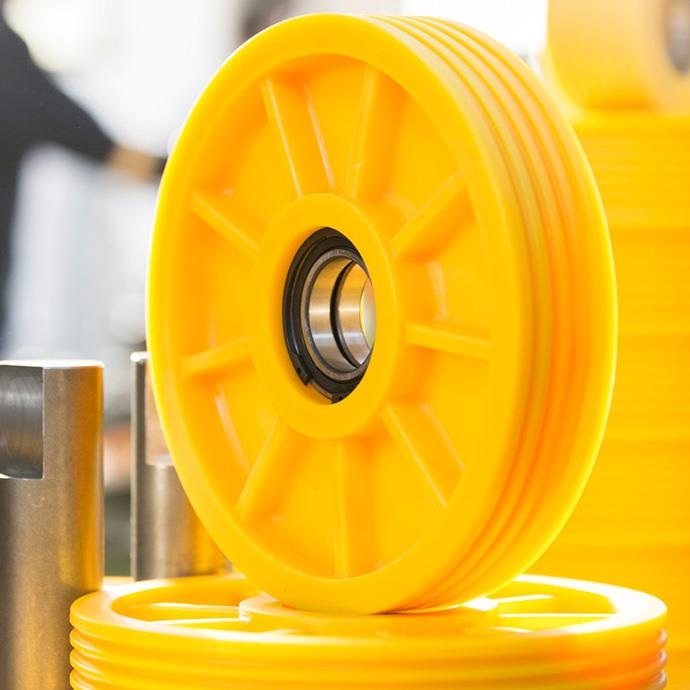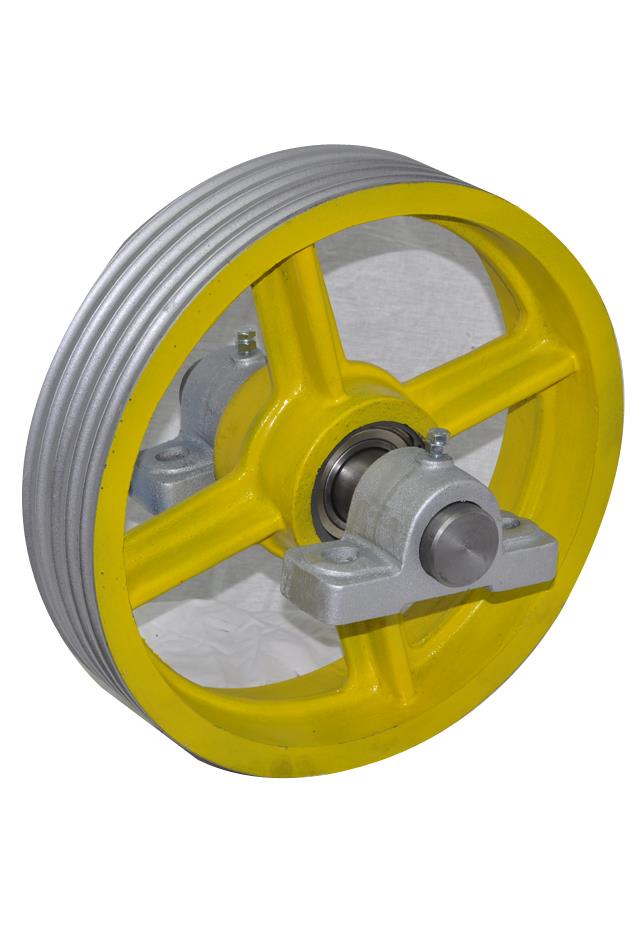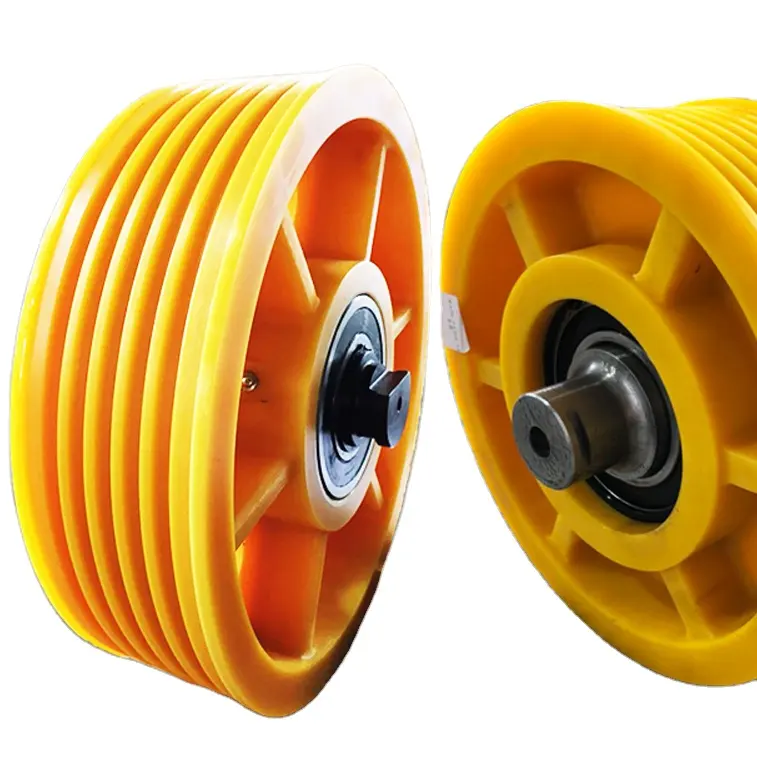Product Description
Product Description
Product Description
| Item | Sheaves/Pulleys |
| Design | Can be at the customer’ request, tailor-made, at customer’s design |
| Application | Cranes, lifting hooks, lifting grabs, lifting beams |
| Material | SAE4140, SAE4150, SAE4160, 42CrMo, 42CrMo4,SAE1045,45#, stainless steel 410,stainless steel 304 |
| Standard | UIC 811-1, EN13261, GOST 31334, IRIS 16/95, KSR 9220, BS 5892, JIS E4502, TB/T 2945 |
| Size | From diameter 250mm to 1250mm. |
| Minimum order | 1 pc |
Manufacturing Process
1.Free forged or module forged
2.Rough machining process, to remove the surface forged oxidized black leather.
3.100% Ultrasonic Test ASTMA388
4.Heat Treatment according to request, Normalized, Quenched, Tempered….
5.Hardness test
6.Finishing Process to the dimensional state required by the drawing.
7.100% Magnetic Test ASTM E709 and 100% dimensional test
8.Painting or oil protecting TECTYL 506 or similar
9.Packing with boxes
Data Needed for Quotation
– Your own drawing
– Your requirement on material and necessary dimensional data
– Ask for recommend
Company Profile
ZheJiang CHINAMFG Machinery Co., Ltd., established in the year of 2012, is a professional supplier of material handling equipment, OEM machinery parts, various forging parts and casting parts.
Ebon’s products scope: cranes, hoists, magnets, grabs, hooks, wheels, drums, axles, lifting beams,bearing box, bearings, couplings,flanges etc. They are applied in wide range of field: Machinery, Mining, Hydro power Transportation, Construction…..
CHINAMFG has 5 reliable manufacturing factories to make sure stable supply and fast delivery for your business.
Our products are also exported to USA, Britain, Japan, South Korea, Russia, Indonesia, Thailand, India, Vietnam, Canada, Argentina, Paraguay etc more than 50 countries.
CHINAMFG team is loyal and committed to your success, and firmly believes that our products and services will increase the value and effectiveness of your business with following characters:
-Professional sales team, market promotion team and logistics team with more then 10 years experience .
-Loyal and Responsible Characters
-Efficient Work, Fast Response
-Responsible Quality Control Team
-Video the manufacturing process, the testing, and packing before delivery
1.Q: How about your delivery time?
A: Generally, it will take 7-30 days after receiving your advance payment. The specific delivery time depends on the items, transportation ways and the quantity of your order.
2.Q: Can you produce according to the samples?
A: Yes, we can produce by your samples or technical drawings.
3.Q: Do you test all your goods before delivery?
A: Yes, we have 100% Ultrasonic test, Magnetic test or Liquid Penetration test before delivery
4.Q: How do you make our business long-term and good relationship?
A: (1) We keep good quality and competitive price to ensure our customers benefit ;
(2) We respect every customer as our friend and we sincerely do business and make friends with them, no matter where they come from.
5.Q: I can’t see the goods or touch the goods, how can I deal with the risk involved?
A: Our quality management system conforms to the requirement of ISO 9001:2015 verified by DNV. We are absolutely worth your trust. We can accept trial order to enhance mutual trust.
| Processing Object: | Metal |
|---|---|
| Molding Style: | Forging |
| Molding Technics: | Pressure Casting |
| Application: | Machinery Parts |
| Material: | Steel |
| Heat Treatment: | Quenching |
| Customization: |
Available
| Customized Request |
|---|
How do lifting pulleys contribute to the longevity and reliability of lifting equipment?
Lifting pulleys play a significant role in enhancing the longevity and reliability of lifting equipment. They contribute to the smooth functioning of the lifting system and help minimize wear and tear on various components. Here’s a detailed explanation of how lifting pulleys contribute to the longevity and reliability of lifting equipment:
1. Load Distribution: Lifting pulleys distribute the weight of the load evenly across the lifting system. By spreading the load over multiple ropes or cables, pulleys reduce the strain on individual components, such as cables, hooks, and attachments. This balanced load distribution minimizes the risk of overloading and premature failure of specific parts, thereby prolonging the lifespan of the lifting equipment.
2. Reduced Stress on Components: Lifting pulleys help to alleviate stress on various components of the lifting system. When lifting heavy loads, the force exerted on the cables or ropes can be substantial. By utilizing pulleys, the load is distributed across multiple ropes or cables, reducing the stress on each individual component. This reduction in stress helps prevent excessive stretching, bending, or breakage of cables, ensuring the reliability and longevity of the lifting equipment.
3. Efficient Force Transmission: Lifting pulleys facilitate efficient force transmission within the lifting system. As the load is distributed and redirected through the pulleys, the force is applied in a controlled and balanced manner. This efficient force transmission minimizes unnecessary strain on the lifting equipment and reduces the risk of sudden jerks or jolts that can cause damage or premature wear.
4. Improved Load Control: Lifting pulleys enable precise control over the lifting process, allowing operators to adjust the speed, direction, and position of the load with accuracy. This precise load control helps in preventing sudden or uncontrolled movements that can put stress on the lifting equipment. By ensuring smooth and controlled load handling, pulleys contribute to the longevity and reliability of the lifting equipment.
5. Reduction in Friction: Lifting pulleys are designed to minimize friction between the pulley and the ropes or cables. They often incorporate ball bearings or other low-friction mechanisms to ensure smooth rotation. By reducing friction, pulleys minimize wear on the ropes or cables, as well as on the pulley itself. This reduction in friction helps to extend the lifespan of the lifting equipment.
6. Protection Against Abrasion: Lifting pulleys can incorporate features such as protective coatings or linings to minimize abrasion and wear on the ropes or cables. These protective measures help prevent damage to the lifting equipment caused by repeated rubbing or contact with rough surfaces. By safeguarding against abrasion, pulleys contribute to the longevity and reliability of the lifting equipment.
7. Maintenance and Serviceability: Lifting pulleys are typically designed for easy maintenance and serviceability. They can be quickly inspected, lubricated, and replaced if necessary. Regular maintenance, including cleaning and lubrication of the pulleys, ensures their optimal performance and extends their lifespan. By facilitating routine maintenance, pulleys contribute to the overall reliability and longevity of the lifting equipment.
8. Compatibility and Interchangeability: Lifting pulleys are often designed to be compatible and interchangeable with various lifting systems and configurations. This compatibility allows for easy replacement or upgrading of pulleys as needed. Interchangeability ensures that pulleys can be seamlessly integrated into the existing lifting equipment, thereby extending its reliability and lifespan.
In conclusion, lifting pulleys play a crucial role in promoting the longevity and reliability of lifting equipment. Through load distribution, stress reduction, efficient force transmission, improved load control, friction reduction, protection against abrasion, maintenance and serviceability, as well as compatibility and interchangeability, pulleys contribute to the smooth functioning and extended lifespan of the lifting equipment.
Are there different types of lifting pulleys, and how do they vary in lifting applications?
Yes, there are different types of lifting pulleys, each with its specific design and functionality, tailored to different lifting applications. The variation in lifting pulleys allows for versatility and adaptability in various lifting scenarios. Here are some common types of lifting pulleys and how they vary in lifting applications:
1. Single Sheave Pulleys: Single sheave pulleys have a single wheel or sheave and are commonly used in simple lifting setups. They provide a basic mechanical advantage and are suitable for light to moderate loads. Single sheave pulleys are often used in applications such as home garage hoists, small boat rigging, or DIY projects where a straightforward lifting solution is required.
2. Double Sheave Pulleys: Double sheave pulleys consist of two sheaves mounted side by side. They provide a higher mechanical advantage compared to single sheave pulleys and are capable of handling heavier loads. Double sheave pulleys are commonly used in block and tackle systems, where multiple pulleys are combined to create a compound mechanical advantage. This type of pulley is well-suited for applications involving heavier loads, such as construction, rigging, or industrial lifting.
3. Multiple Sheave Block Pulleys: Multiple sheave block pulleys, also known as block and tackle systems, consist of three or more sheaves arranged in a block. This configuration allows for even greater mechanical advantage and load distribution. Block and tackle systems are used in demanding lifting operations where extremely heavy loads need to be lifted with reduced effort. Examples of applications include shipyard cranes, construction tower cranes, or heavy-duty industrial lifting.
4. Snatch Blocks: Snatch blocks are specialized pulleys designed for specific applications, such as recovery operations and rigging in off-road vehicles or marine environments. They typically feature a hinged opening that allows the cable or rope to be easily inserted or removed without the need for threading. Snatch blocks offer flexibility and convenience in various lifting and pulling scenarios.
5. Swivel Pulleys: Swivel pulleys have a rotating mechanism that allows the pulley to rotate freely, independent of the attachment point. This design enables the lifting cable or rope to follow a natural path and reduces the chance of twisting or tangling. Swivel pulleys are commonly used in lifting operations where the load needs to be maneuvered or rotated, such as aerial work platforms or material handling in confined spaces.
6. Specialized Pulleys: There are various specialized pulleys designed for specific industries or lifting applications. For example, rescue pulleys are designed for emergency and rescue operations and often feature built-in safety features. High-temperature pulleys are designed to withstand extreme heat environments, such as in foundries or glass manufacturing. Corrosion-resistant pulleys are used in marine or corrosive environments where protection against rust and degradation is crucial.
The choice of lifting pulley depends on factors such as load capacity, required mechanical advantage, environmental conditions, space limitations, and specific lifting needs. By selecting the appropriate type of pulley, operators can ensure safe and efficient lifting operations across different industries and applications.
How do lifting pulleys contribute to the smooth and controlled lifting of heavy loads?
Lifting pulleys play a crucial role in achieving smooth and controlled lifting of heavy loads. They provide mechanical advantage and facilitate the efficient transfer of force, allowing operators to lift heavy objects with reduced effort and improved control. Here are several ways in which lifting pulleys contribute to smooth and controlled lifting:
1. Mechanical Advantage: Lifting pulleys employ the principle of mechanical advantage to make lifting heavy loads easier. By using multiple sheaves or wheels, they distribute the load over several ropes or cables. This distribution of load reduces the amount of force required to lift the load. The mechanical advantage provided by lifting pulleys allows operators to exert less force while achieving the desired lifting outcome.
2. Reduction of Friction: Lifting pulleys are designed to minimize friction between the rope or cable and the pulley itself. They often feature smooth, rounded grooves or ball bearings, which reduce the contact area and frictional forces. By reducing friction, lifting pulleys enable smoother movement of the lifting medium, such as a rope or cable, resulting in a more controlled lifting process.
3. Change of Direction: Lifting pulleys allow for changes in the direction of the lifting force. By redirecting the force at different angles, pulleys enable lifting from various positions, even in confined spaces. This capability enhances flexibility and control during lifting operations, allowing operators to maneuver heavy loads with precision.
4. Force Amplification: Lifting pulleys amplify the input force applied by the operator. As the force is transmitted through the pulley system, the load experiences increased lifting force. This force amplification can be particularly beneficial when dealing with heavy loads that would require excessive force to lift without the mechanical advantage provided by the pulleys.
5. Controlled Speed: Lifting pulleys offer control over the lifting speed. By adjusting the tension and angle of the ropes or cables, operators can regulate the rate at which the load is lifted or lowered. This control is crucial for delicate or sensitive loads that require careful handling and precise positioning.
6. Stability and Safety: Lifting pulleys contribute to the stability and safety of lifting operations. They help to evenly distribute the load, reducing the risk of imbalance or tipping. Additionally, the mechanical advantage provided by the pulleys allows for smoother and more controlled movements, minimizing the likelihood of sudden jolts or jerks that could compromise the safety of the load, equipment, or personnel involved.
By utilizing mechanical advantage, reducing friction, enabling changes in direction, amplifying force, providing controlled speed, and enhancing stability and safety, lifting pulleys significantly contribute to the smooth and controlled lifting of heavy loads. Their design and functionality make them indispensable tools in various industries where material handling and lifting operations are essential.
editor by CX
2023-10-03




